India in
Colour
“I had been seeing the world in black & white and, when brought face-to-face with India, experienced everything re-rendered in brilliant technicolour.”
Keith Bellows, National Geographic Society
India is alive with a dizzying array of sights, sounds and colours. With 7,500 miles of coastline, India’s land varies magnificently. The north is home to both the wettest place and the highest mountain range in the world, the west boasts beautiful beaches and tropical rainforests. The much revered River Ganges snakes through the east, and the southern-most tip slopes down into the Indian Ocean.
The richness of its culture and the diversity of its people are only matched by the vibrancy of India’s traditions. It is a country steeped in religious belief, where the powers and mythical lives of its gods tell the story of the importance of colour. The colours of India are ingrained in its consciousness and each colour holds important cultural, religious and traditional meaning. India is a land whose story can best be told through colour.

India is famous for its high grade saffron, it is referred to as ‘gold in edible form’.
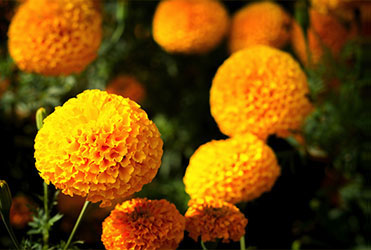
Representing the sun, Marigolds are used in Indian weddings to bring brightness and positive energy to the couple.

The ‘Sun City’, or Jodhpur, features houses painted a vivid blue.

One of the most popular flavours, coriander is used widely in Indian cooking.
Green
Green Doorway at Jaipur City Palace
India is largely an agricultural country, and the green of the harvest signifies happiness and new beginnings. The colour is considered a manifestation of god himself, as it epitomises nature. One of India’s traditional folk tales tells of how the all-knowing blue of the sky came together with the golden yellow energy of the sun to create the emerald hue. Central to life and growth, after the dry summer, rain comes and brings new life in the colour green.
It is also the revered colour of Islam, a large religious presence in India. The prophet Muhammad named green as the colour of nature. It holds important significance in the faith and is widely used in the Koran in reference to paradise.

Known as ‘Queen of the Spices’, cardamom is the world’s third most expensive spice and native to southern India.

Popular in all manner of Indian dishes, Okra is believed to increase brain power.

Wearing green is believed to reinstate your energy and inspire harmony in others.

A firm favourite in Indian cookery, coriander seeds are one of the main components of Gram Masala.
Blue
Jodhpur – The Blue City
Lord Krishna taught mankind the correct way to live, he is famous for his blue-toned skin. Blue represents power and life, it is also the colour of water. Water is a vital resource for an agricultural nation as it sustains all life on earth. Anything infinite is represented by blue, such as the ocean and sky, this is also why Krishna is depicted in blue.
Ringed by a high stone wall, Jodhpur rises out of the Thar Desert in Northern India and is the second largest city in Rajasthan. Known as the ‘Blue City’, Jodhpur stands in vibrant contrast to the surrounding scorched earth of the desert.

Lord Krishna is believed to be the embodiment of divine joy and love, he destroys all pain and sin.

The national bird of India, the peacock is a symbol of beauty, grace, joy and love.

It’s uncertain why the locals began painting their houses blue in the city of Jodhpur, but the city resembles an oasis in the desert.
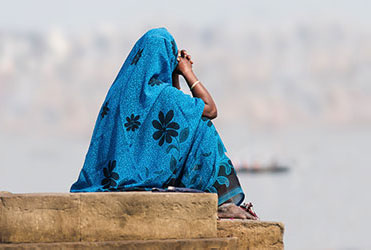
The colour of peace and serenity, wearing blue is believed to have a calming effect.
Yellow
Golden Temple - Harmandir Sahib
Yellow is sacred and symbolises the balance of life, it is the centre colour between the shades of red and blue. The colour yellow shares the same healing qualities as the sun, emanating warmth, optimism and light. Yellow is the colour of spring and is worn to celebrate the Hindu festival Vasant Panchami. During this festival, celebrants wear yellow; the goddess Saraswati wears a yellow dress and yellow sweets and saffron rice are eaten.
The Harmandir Sahib, known as the Golden Temple, can be found in the city of Amritsar. It is the holiest Sikh Gurdwara, and welcomes people of all religions. Called India’s Shining Star, the dome is gilded with 750kg of pure gold. This is a popular pilgrimage site rather than a tourist attraction and everyone is welcome to enjoy the serenity of the glistening temple.
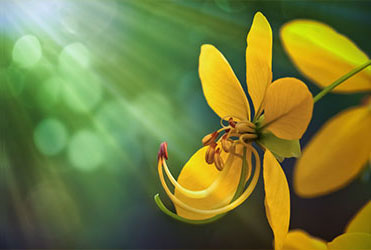
The Amaltas Tree brings bright yellow to the landscape during India’s dry season. The flowers are also an important part of religious festivals.

Lord Vishnu and his wife the Goddess Lakshmi, often called ‘the ideal couple’, are worshipped with marigolds.
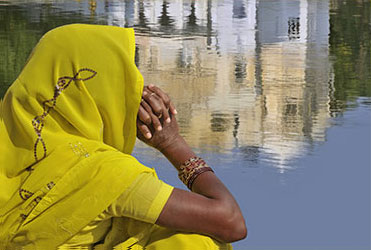
Yellow is believed to have the same qualities as the sun, wearing yellow will rejuvenate and balance the mind.
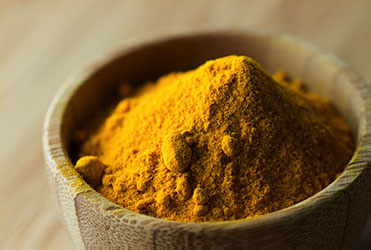
Linked to fertility and the sun, turmeric is used in Indian wedding ceremonies to represent inner purity and pride.
Red
The Red Fort - New Delhi
In Bengal, the colour red is symbolic of the Goddess Durga who is often seen draped in a red sari. The colour red can incite fear, but also stands for life giving purity; Indian brides often wear red on their wedding day. The colour also represents fertility and opulence.
The red tilak, a red mark placed on the forehead, is used universally across India as a ritual mark of welcome. The tilak symbolises the third eye of the Lord Shiva and is believed to protect the inner wisdom of those it is placed upon. The red bindi, a form of tilak, was traditionally a simple mark worn by married women. Believed to protect wives and their husbands, it is more common today as a decorative accessory.
Located in New Delhi, the Red Fort gets its name from its red sandstone walls. Built in 1638, it is surrounded by moats fed by the Yamuna River. Residence of the emperor of India for almost two hundred years, today visitors can get a taste for the splendour of the lives of the Maharajas.

Cultivated mainly in Jammu and Kashmir, saffron is a symbol of freshness and purity.

Mace is derived from the lacy covering of the nutmeg shell, it is similar to nutmeg, but the flavour is stronger.
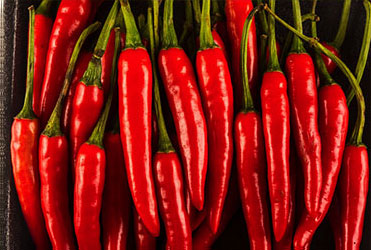
With many different varieties grown all over India, chilli is used by farmers to keep elephants away from crops.
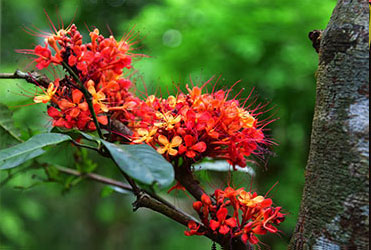
Considered sacred throughout India, the Ashoka tree is often found in palace gardens and next to temples.
White
The Taj Mahal – Agra
White is a calm colour which represents serenity and spreads the message of peace. It is the colour from which all other colours emerge, and so stands for purity. The five main shades of white are represented in nature by the August moon, the conch shell, clouds when the rain is spent, the white surf of the sea and the fragrant white of Jasmine flowers. The colour softens the summer heat, reflects light and keeps the wearer cool.
Widows traditionally used to wear white, it is the colour worn at cremation ceremonies to say a peaceful farewell to the deceased. The colour marks the end of the human journey on earth and symbolises complete disconnection with the material world. The world’s most iconic mausoleum, The Taj Mahal is crafted out of white marble as a memorial to Emperor Shah Jahan’s beloved third wife, Mumtaz Mahal.

The national flower of India, the Lotus signifies fertility, divinity, wealth, enlightenment and knowledge.

Jasmine is used in Indian wedding ceremonies to symbolise sensuousness and proximity between the couple.
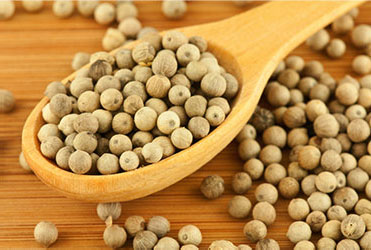
White pepper is grown in southern India and has a warmer taste as it is left on the vine longer to mature.
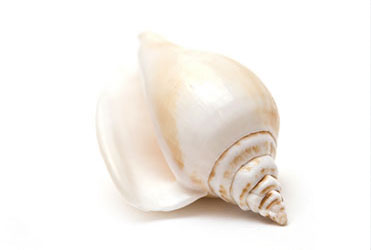
Conch shells hold religious significance for both Hindus and Buddhists. Throughout Indian history it has been a symbol of power, authority and sovereignty.
Add colour to your journey
Although India is a country of diverse landscapes, faiths and people, colour unites them. Colour brings people together with emotions more significant than any differences. Travelling across India, you will see vast differences in the landscape, the traditions and people, but the constant will be colour. Travelling by train with Great Rail Journeys, you get a chance to experience the real India. The relaxed pace of your journey gives you the chance to fully appreciate the country and its cultures. Experience the lifestyle of the Maharajas by travelling on India’s Palace on Wheels, a luxury tour of some of the country’s most colourful cities. Visit ‘India’s Golden Triangle’ and discover thriving cities and spectacular palaces. On an escorted tour of India with Great Rail Journeys, travelling between India’s stunning destinations is as enjoyable as the destinations themselves.
 A journey on India’s stunning luxury train, The Palace on Wheels, will take you through some of the country’s most famous cities. Immerse yourselves in the lives of the Maharajas, visiting historic palaces and travelling in the lap of luxury.
A journey on India’s stunning luxury train, The Palace on Wheels, will take you through some of the country’s most famous cities. Immerse yourselves in the lives of the Maharajas, visiting historic palaces and travelling in the lap of luxury.
 Experience the delights of Delhi, Agra and Jaipur - along the way you’ll see The Red Fort, The Taj Mahal and ‘The Pink City’. Get a detailed insight into the lives and culture of the country, and familiarise yourself with the bold and beautiful colours of India on our Golden Triangle Tour.
Experience the delights of Delhi, Agra and Jaipur - along the way you’ll see The Red Fort, The Taj Mahal and ‘The Pink City’. Get a detailed insight into the lives and culture of the country, and familiarise yourself with the bold and beautiful colours of India on our Golden Triangle Tour.

© Great Rail Journeys 2015
